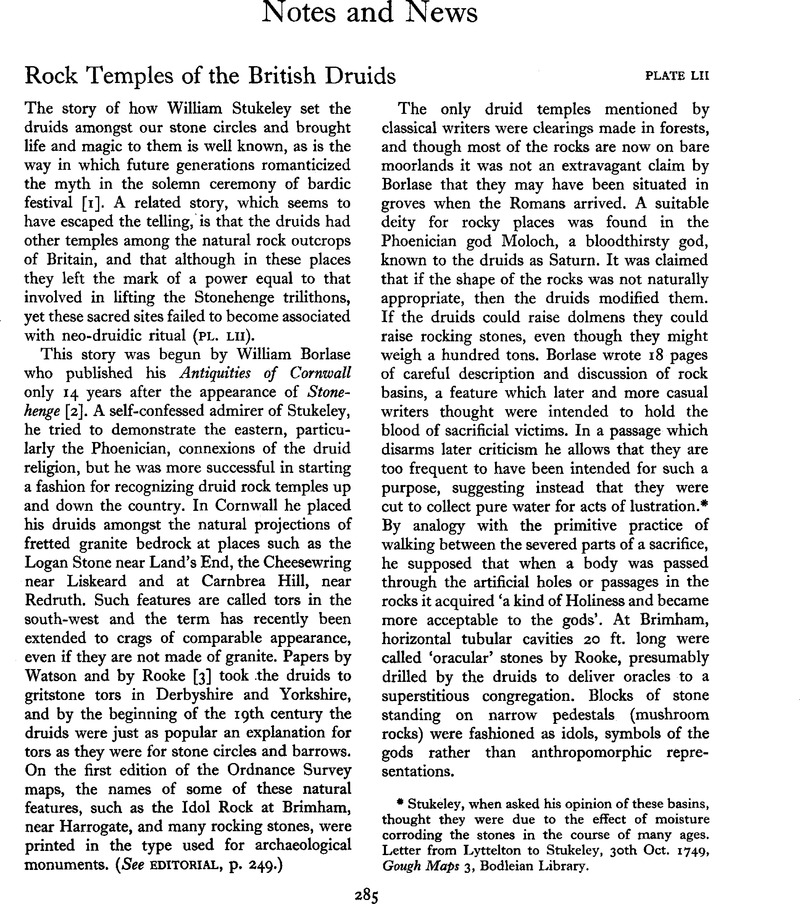No CrossRef data available.
Published online by Cambridge University Press: 02 January 2015

[1] T.D. Kendrick, The Druids (1927); A.L. Owen, The Famous Druids (1962); S. Piggott, ‘The Druids and Stonehenge’, in Myth or Legend? (1955) by G.E. Daniel and others; S. Piggott, William Stukeley, An Eighteenth Century Antiquary (1950); Iorwerth Peate, ‘The Gorsedd of the Bards of Britain’, antiquity, 1951, 13–15.
[2] W. Stukeley, Stonehenge. A Temple restor’d to the British Druids (1740) ; W. Borlase, Observations of the Antiquities, History and Monuments of the County of Cornwall (1754).
[3] Watson, J., ‘Druidical Remains in and near the Parish of Halifax in Yorkshire, Discovered and Explained’, Archaeologia, 2, 1773, 353–64 CrossRefGoogle Scholar; Rooke, H., ‘A Further Account of some Druidical Remains in Derbyshire’, Archaeologia, 7, 1783, 1757 Google Scholar; Rooke, H., ‘Some Account of the Brimham Rocks in Yorkshire’, Archaeologia, 8, 1787, 209–17 CrossRefGoogle Scholar; Rooke, H., ‘Description of some Druidical Remains on Harborough Rocks, etc. in Derbyshire’, Archaeologia, 9, 1789, 206–10 CrossRefGoogle Scholar; Rooke, H., ‘An Account of some Druidical Remains in Derbyshire’, Archaeologia, 12, 1796, 41–9 Google Scholar.
[4] MacCulloch, J., ‘On the Granite Tors of Cornwall’, Trans. Geological Society, 2, 1814, 6678 Google Scholar.
[5] A letter by Drake, F. E., ‘The Artificial Origin of Rock Basins’, The Geologist, 2, 1859, 368–71 Google Scholar.
[6] ‘We should wish to find any person, who can clearly prove, on good authority that the Druids were not there’. Anon., Historical and Descriptive Account of Brimham Rocks, 2nd ed. (1838).Google Scholar The statement is missing from the 5th ed. of 1845.
[7] Ormorod, G. W., ‘A letter on Druid Antiquities’, Athenaeum, 4th Oct. 1856, no. 1510, p. 1226 Google Scholar.
[8] T. Pennant, A Tour from Alston Moor to €€arrogate and Brimham Crags (1804); Bigland, J., Beauties of England and Wales (1812), vol. 16 (Yorkshire)Google Scholar; Farrer, W., History of Ripon, 2nd ed. (1806)Google Scholar.
[9] Anon., A Descriptive Account of Brimham Rocks, 5th ed. (Ripon, 1845).Google Scholar While modern man may think these natural wonders are impressive, ancient man does not seem to have developed them as cult centres. Neither have they much attracted the artist. One is left to wonder why. Perhaps they were too inaccessible at the height of the Romantic Movement. The 2nd edition of the Brimham guide was ‘improved’, but the roads were only ‘improving’.
[10] Editorial in antiquity, 1961, 173–4. One should add that rocking stones are known to have been overturned with crowbars in several places.